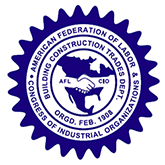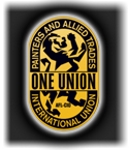The first priority of the painter/sheetrock finisher/wall-coverer is to prepare the surface for the finishes to be applied. Some of the processes that are used in the industry are new and modern techniques developed to meet today’s industry, while others such as Venetian plastering date back to ancient times.
Painters
Work will include, preparation, application and removal of all types of coatings and coatings systems in relation to all painting, decorating, protective coatings, toppings, waterproofing, masonry restoration, fiber glassing, F-Glass fiberglass, metalizing, flame spray, and the applications of Exterior Insulating Finishing Systems Each such application and similar or substitute on all application of Exterior or interior surfaces including residences, buildings structures industrial, power, chemical and manufacturing plants, bridges, tanks, vats, pipes, stacks, light and high tension poles, parking, traffic and air strip lines, trucks, automobile and railroad cars, ships, aircraft and all machinery and equipment.
Material used in preparation and application include but are not limited to thinners, dryers, sealers, binders, pigments, primers, extenders, air and vapor barriers, emulsions, waxes, stains, mashes, plastics, enamels, acrylics, alkyds, epoxies, epoxy injection, sheet rubber, foams, seamless and tile like coatings. Preparation for and removal of any materials for finishes, such as deep cleaning, patching, caulking, high pressure water, chemical and abrasive blasting, environmental blasting, wet/dry vacuum work, chemical stripping, scraping, air tooling bleaching, steam cleaning, and lead abatement/removal.
Drywall Finishers
Work will include, but not limited to the preparation or leveling of any surface or substrate which is to receive a coating, finish and/or wall covering. This will include all levels of finishing and/or spackling of all surfaces, including gypsum wallboard taping and finishing, fire taping and all fire stooping systems, glaze coatings, floating, sealing joint angles, internal and external corners skim coatings, spotting of nails, finishing of corner beads/flex beads. A skilled drywall finisher will be organized and capable of independently finishing sheetrock at all levels Drywall finishers must be proficient in the use of hand tools as well as automatic finishing tools.
Wall Covering
The Wall Coverer measures the surface he/she is to cover for the covering to fit Next mixes the adhesive, applies it to the back of the wall covering, places the wall covering in the correct position to the wall and smoothes it with a smoothing brush or knife. They are careful to match the pattern, making sure the design continues from strip to strip without a visible break, Wall-covers may also estimate the cost and material for each job, produce decorative designs, restore wood color by bleaching or applying staples, tacks, by stretching or adhered by any other method, including all papers, vinyl’s, flexible woods, fabrics, borders, metals, upholstered wall systems, the fabric covered panels made of plastic/wood or pre-finished products of micro fiberglass, acrovin and various plastic wall coverings such as wainscoat, caps, corner moldings and accessories. Some preparation of walls and ceilings such as scraping or any methodology for removal of existing materials, including patching, leveling, skim coating, and priming.
Working Conditions
Painting is strenuous work, requiring walking, standing, reaching, kneeling, stooping, climbing and carrying. Occupational hazards include fails from ladders, scaffolds and skin or throat irritations from paint vapors and thinners. Painters lose some work time each year due to bad weather. Safety is stressed in all aspects of the trade due to paint and related materials, vapors and dust, fails from elevated work platforms and ladders. Safety classes are an ongoing process of the Journeymen and Apprentice in order to have a work place that protects the workers and the environment.
Interest and Temperament
Painters must have manual dexterity as well as steady to work in high places. They should not be allergic to paint vapors or materials used in the trade. As artistic sense, good eyesight, and sense of color are necessary to do a first class job
Contact Information
District Council 80, Local #1244
2669 Lexington Ave.
Kenner, LA 70062
Tele. 504-466-4114
Bert Santos
Business Manager
Mike Kaufman
Business Representative
August Santos
Apprenticeship Coordinator
How do I prepare for the trade?
The following will be helpful:
- Chemistry
- General Math
- General Science
Terms of Apprenticeship.
- Three (3) years of On-Job-Training
- Related classroom instruction that covers wall-covering, painting and drywall finishing (144 hours per year)

